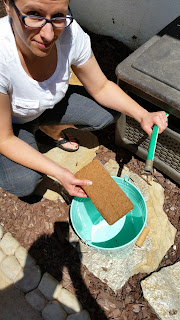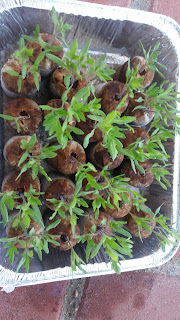 |
| COCONUT COIR BRICKS |
The addition of water increases the volume 3 to 9 times, depending on the packaging of products. This process results in a 100% organic, biodegradable growing medium, making it a natural and safe growth medium of choice for growers.
1.5 pounds compressed brick
Add water to increase volume 3 to 9 times!
 |
| Coconut Coir Bricks: Just add water! |
-Unlike peat moss, which is highly acidic, coconut coir has a neutral pH level. Most garden vegetables and flowers grow best in neutral to slightly alkaline conditions. When you use peat to amend a garden bed, an addition of agricultural lime is often necessary to combat the higher acidity. With coconut coir, limestone isn't necessary unless the soil naturally has a higher pH level. Coir use results in both a monetary and a labor savings, since you don't need to purchase further pH amendments nor work them into the soil.
-Coir improves soil drainage in the bed while also helping to retain moisture in quick-draining soils. Since coir breaks down slowly, much like peat, it creates air pockets in the soil that allow excess moisture to drain away from plant roots. The coir itself holds onto some moisture so the drainage doesn't occur too quickly and the soil doesn't dry out completely. These dual drainage and retention properties allow coir to improve moisture management in both heavy clay soils and dry, sandy beds.
-Peat moss, which coir replaces as a soil amendment, takes centuries to regrow once harvested. Coir is completely sustainable since it is a natural byproduct of coconut harvests, and coconut trees produce new coconuts every year. Using the coir in the garden keeps it out of the landfill where it would otherwise go. Coir can take a century or longer to fully break down in these landfills, so it's more sustainable to use it to improve your garden soil.
 |
| Coconut Coir Pellets are great for seed starting |
If you have additional questions about getting started or would like more info please feel free to ask. As always, I am happy to help.
If you'd like to check out some of our gardening tips, check out our fb page.
Sign up for our E-Newsletter


4 comments
Great info on the coconut coir! I’ve always used peat moss but am going to try this great product! Thanks for the info!
I have heard alot about this lately! I will be trying it this year!
Hi Karen!
Greens are a great option for growing in containers! We have a few tips for container gardens here on our blog
https://www.marysheirloomseeds.com/blogs/news/101783937-growing-in-containers
https://www.marysheirloomseeds.com/blogs/news/101845121-start-a-bucket-garden
I hope this helps. If you have additional questions please feel free to ask or just send an email to mary@marysheirloomseeds.com
-Mary
I am hoping to start growing a variety of greens and I was wondering if they can be grown in containers on my lanai. We live in Central Florida (Ocoee).
Thank you in advance!
Karen